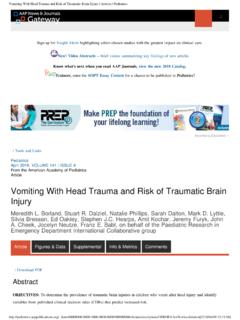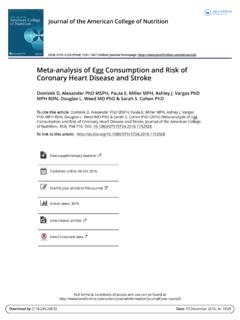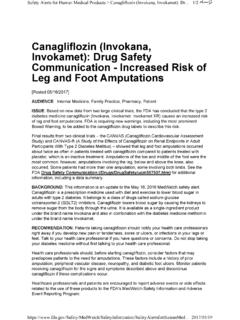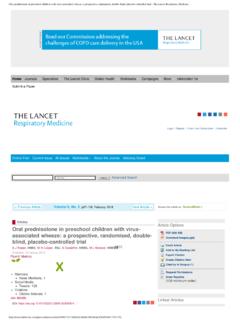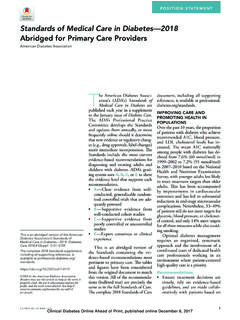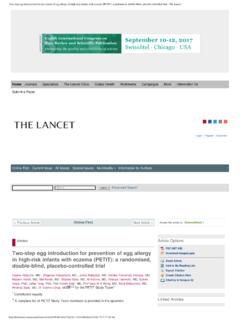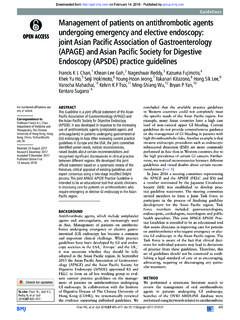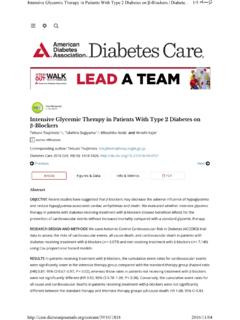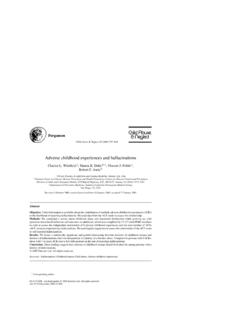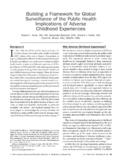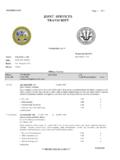Transcription of Management of Hyperglycemia in Type 2 Diabetes, 2018. A ...
1 Diabetes Care 1. Melanie J. Davies,1,2 David A. D'Alessio,3. Management of Hyperglycemia Judith Fradkin,4 Walter N. Kernan,5. Chantal Mathieu,6 Geltrude Mingrone,7,8. in Type 2 Diabetes, 2018. Peter Rossing,9,10 Apostolos Tsapas,11. Deborah J. Wexler,12,13 and John B. Buse14. A Consensus Report by the American Diabetes Association (ADA) and the European Association for the study of Diabetes (EASD). CONSENSUS REPORT. 1. Diabetes Research Centre, University of Leices- ter, Leicester, 2. Leicester Diabetes Centre, Leicester General Hospital, Leicester, 3. Department of Medicine, Duke University School of Medicine, Durham, NC. 4. National Institute of Diabetes and Digestive and Kidney Diseases, National Institutes of The American Diabetes Association and the European Association for the study of Health, Bethesda, MD.
2 Diabetes convened a panel to update the prior position statements, published in 5. Department of Medicine, Yale School of Med- 2012 and 2015, on the Management of type 2 diabetes in adults. A systematic icine, New Haven, CT. 6. evaluation of the literature since 2014 informed new recommendations. These Clinical and Experimental Endocrinology, UZ. Gasthuisberg, KU Leuven, Leuven, Belgium include additional focus on lifestyle Management and diabetes self- Management 7. Department of Internal Medicine, Catholic Uni- education and support. For those with obesity, efforts targeting weight loss, versity, Rome, Italy 8. including lifestyle, medication, and surgical interventions, are recommended.
3 With Diabetes and Nutritional Sciences, King's College regards to medication Management , for patients with clinical cardiovascular London, London, 9. Steno Diabetes Center Copenhagen, Gentofte, disease, a sodium glucose cotransporter 2 (SGLT2) inhibitor or a glucagon-like Denmark peptide 1 (GLP-1) receptor agonist with proven cardiovascular bene t is recom- 10. University of Copenhagen, Copenhagen, Den- mended. For patients with chronic kidney disease or clinical heart failure and mark 11. Second Medical Department, Aristotle Univer- atherosclerotic cardiovascular disease, an SGLT2 inhibitor with proven bene t is sity Thessaloniki, Thessaloniki, Greece recommended.
4 GLP-1 receptor agonists are generally recommended as the rst 12. Department of Medicine and Diabetes Unit, injectable medication. Massachusetts General Hospital, Boston, MA. 13. Harvard Medical School, Boston, MA. 14. Department of Medicine, University of North The goals of treatment for type 2 diabetes are to prevent or delay complications and Carolina School of Medicine, Chapel Hill, NC. maintain quality of life (Fig. 1). This requires control of glycemia and cardiovascular risk Corresponding author: John B. Buse, jbuse@med factor Management , regular follow-up, and, importantly, a patient-centered approach . to enhance patient engagement in self-care activities (1).
5 Careful consideration of and were co-chairs for the Consensus patient factors and preferences must inform the process of individualizing treatment Statement Writing Group. 'A., , , goals and strategies (2,3). and were the writing group members for the American Diabetes Association. , , This consensus report addresses the approaches to Management of glycemia in , and were writing group members for the adults with type 2 diabetes, with the goal of reducing complications and maintaining European Association for the study of Diabetes. quality of life in the context of comprehensive cardiovascular risk Management and This article is being simultaneously published in patient-centered care.
6 The principles of how this can be achieved are summarized in Diabetes Care and Diabetologia by the American Fig. 1 and underpin the approach to Management and care. These recommendations Diabetes Association and the European Associ- are not generally applicable to patients with monogenic diabetes, secondary diabetes, ation for the study of Diabetes. or type 1 diabetes, or to children. 2018 American Diabetes Association and European Association for the study of Diabetes. Data Sources, Searches, and study Selection Readers may use this article as long as the work is properly cited, the use is educational and not The writing group accepted the 2012 (4) and 2015 (5) editions of this position for pro t, and the work is not altered.
7 More infor- statement as a starting point. To identify newer evidence, a search was conducted on mation is available at PubMed for randomized clinical trials (RCTs), systematic reviews, and meta-analyses .org/content/license. Diabetes Care Publish Ahead of Print, published online October 4, 2018. 2. Consensus Report Figure 1 Decision cycle for patient-centered glycemic Management in type 2 diabetes. Diabetes Care Davies and Associates 3. published in English between 1 January studies with other medication classes. laboratories ( ) (11). As 2014 and 28 February 2018; eligible The greatest absolute risk reduction with any laboratory test, HbA1c has lim- publications examined the effectiveness (ARR) comes from improving poor gly- itations (2).
8 Because there is variability or safety of pharmacological or nonphar- cemic control, and a more modest re- in the measurement of HbA1c, clinicians macological interventions in adults with duction results from near normalization should exercise judgment, particularly type 2 diabetes mellitus. Reference lists of glycemia (6). The impact of glucose when the result is close to the threshold were scanned in eligible reports to iden- control on macrovascular complica- that might prompt a change in therapy. tify additional articles relevant to the sub- tions is less certain. Because the bene- HbA1c results may be discrepant from the ject. Details on the keywords and the ts of intensive glucose control emerge patient's true mean glycemia in certain search strategy are available at https:// slowly, while the harms can be immedi- racial and ethnic groups, and in condi- Papers ate, people with longer life expectancy tions that alter red blood cell turnover, were grouped according to subject, and have more to gain from intensive glu- such as anemia, end-stage renal disease the authors reviewed this new evidence to cose control.
9 A reasonable HbA1c target (ESRD) (especially with erythropoietin inform the consensus recommendations. for most nonpregnant adults with suf - therapy), and pregnancy, or if an HbA1c The draft consensus recommendations cient life expectancy to see microvascu- assay sensitive to hemoglobin variants were peer reviewed (see Acknowledg- lar bene ts (generally ;10 years) is is used in someone with sickle cell trait ments ), and suggestions incorporated around 53 mmol/mol (7%) or less (6). or other hemoglobinopathy. Discrep- as deemed appropriate by the authors. Glycemic treatment targets should be ancies between measured HbA1c and Nevertheless, though evidence-based, individualized based on patient prefer- measured or reported glucose levels the recommendations presented herein ences and goals, risk of adverse effects should prompt consideration that one are the opinions of the authors.
10 Of therapy ( , hypoglycemia and of these may not be reliable (12). weight gain), and patient characteris- Regular self-monitoring of blood glucose The Rationale, Importance, and tics, including frailty and comorbid (SMBG) may help with self- Management Context of Glucose-Lowering conditions (2). and medication adjustment, particularly Treatment Atherosclerotic cardiovascular dis- in individuals taking insulin. SMBG plans Lifestyle Management , including medical ease (ASCVD) is the leading cause of should be individualized. People with nutrition therapy (MNT), physical activ- death in people with type 2 diabetes diabetes and the health care team should ity, weight loss, counseling for smoking (7).

